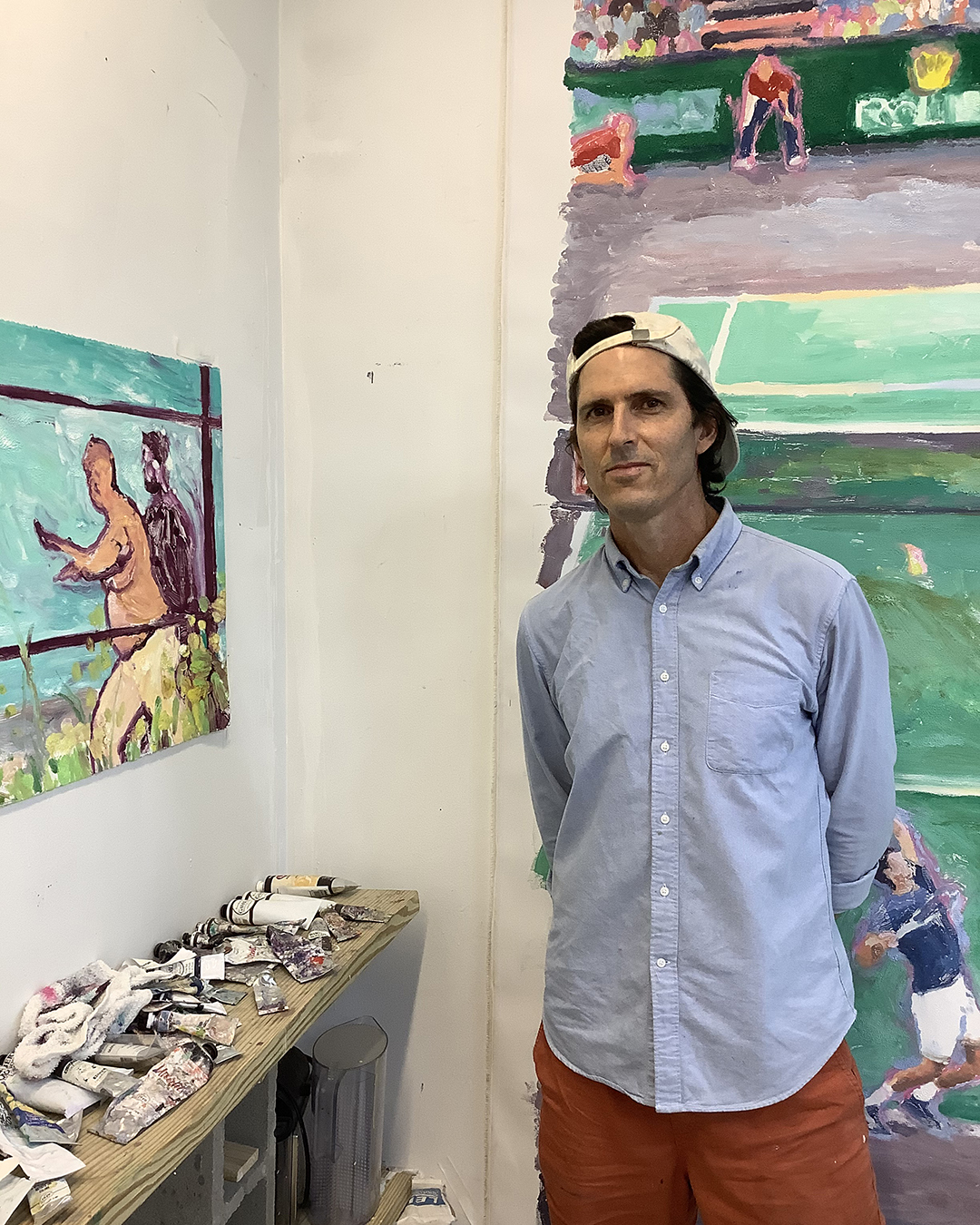
Photos & Words by Anthony Pappalardo
Brian Lotti is a Brooklyn, New York-based painter. Like many denizens entrenched in the ‘80s/’90s skateboarding culture, certain brands and skaters grew to symbolize more than tricks or accomplishments; they became important timestamps and jumping-off points for creativity. This was my introduction to Lotti’s form of expression, not just in skateboarding but the precision and freedom he exuded—equally progressive and expressive. Street skating in the early-’90s was a renaissance but not only in tricks, it was a change of aesthetics and presentation that birthed many creatives.
Unlike many of his peers, Lotti’s personal evolution sprawled past the streets and industry and into universities and even Buddhist monasteries. He stepped out of skating around 1993 to pursue other creative endeavors but sharing a through-line of feeling. As a painter and filmmaker, he’s able to animate the mundane and underappreciated much like he did on curbs, ledges, and schoolyards but it’s never literal or obvious.
I’d liken his work to the snapshots that exist in our minds of everyday moments that somehow stick in the backs of our brains vividly. Unlike memory which often proves to be more false than true and more romantic than palpable, his work evokes feeling through process, intuition, and individuality.
After a brief visit to his Brooklyn studio, we chopped it up about painting and I quickly learned how little I knew about the visual renaissance he’s entrenched and thriving in.
I’m really interested to hear what types of art/artists you were reacting to early on and how that lead to you pursuing art seriously.
Early on Van Gogh and Manet and Monet were very appealing as I had been painting outside for fun and loved it, so landscape painting was a language I could sort of understand. After the Impressionists I was really taken in with post-war American art—the Abex painters like Rothko and then reading Motherwell and then Helen Frankenthaler’s color field paintings and knowing that in New York City, America really had a moment, and moved the whole color-light-composition thing forward in an interesting way. Then Richard Diebenkorn and Wayne Thiebaud on the West Coast, especially when I was in the Bay Area finishing school and seeing that diagonal city through their eyes and appreciating that the Beat Poets and writers were also having epic moments and creating original, meaningful work in the same places at the same time in Berkeley and San Francisco.
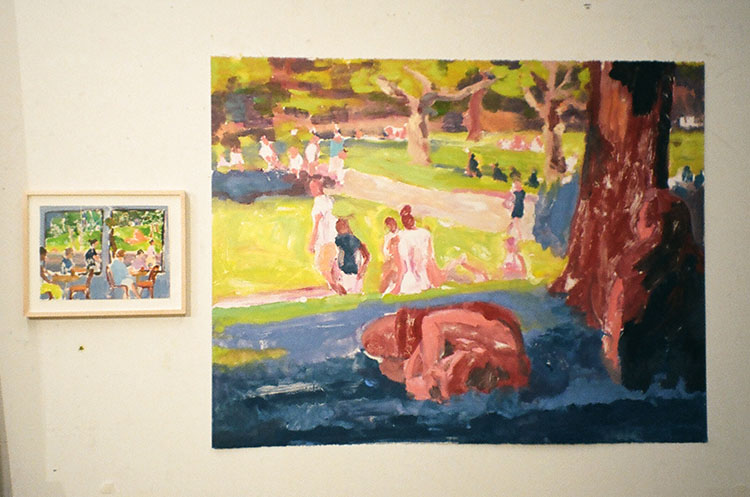
What were your biggest takeaways from formally learning how to paint/make images? And do you think formal schooling helps develop an eye for “successful vs. not successful” meaning, you get a bit better at knowing why something isn’t working rather than just making things and hoping they come out the way you intended.
School helped me learn a bunch about the materials and techniques related to oil painting. The chemistry of getting paints to dry slower or faster and learning about colors and how to mix colors….. running a painting studio is not too different from being a scientist running a lab. I learned to be really hands-on with the materials at the same time I was learning the history of art and specifically the history of 20th-century painting. Part of what we can see in a good art history class is that there’s this continuity of themes and materials that kind of runs through artist’s works whether they realize it or not. All art making exists in this grand tradition that can be tapped for endless inspiration.
As a former pro skater, how come you never did the graphics for them or was it simply because you had Chris Miller doing them?
Good question… I wasn’t doing much outside of skateboarding at the time, to be honest. I never really did much graphic drawing and when I did get into drawing it was so I could make a painting. I was more interested in painterly paintings like the one on the cover of Dinosaur Jr’s. album Where You Been than I was in graphic design or Pantone colors or any of that jazz.
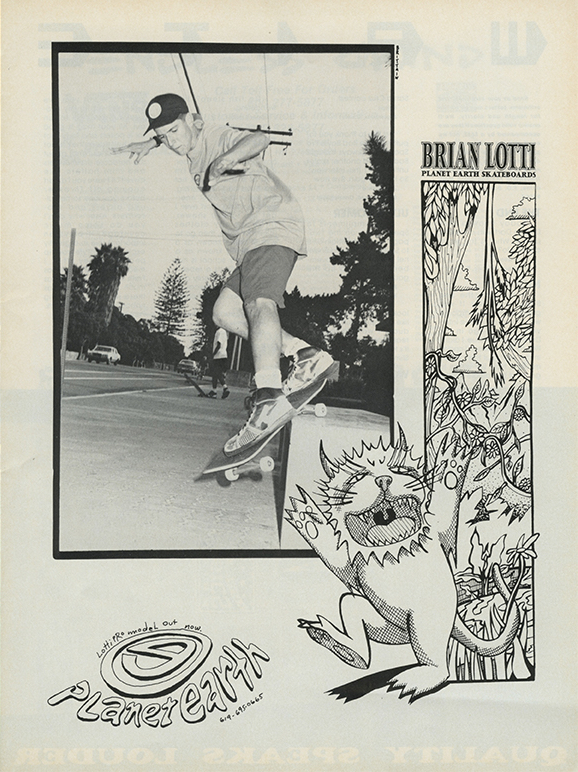
I have some collages you’ve done that have to be almost 10 years old now but it seems as if you’ve really honed in on landscapes or observational painting since then. Can you talk about that shift and focus?
I don’t know, I just love painting. I love paint. I love the smell of it, I love oils and working with oil… I don’t even draw as much as I used to… I spend most of my time painting. It’s a living tradition like skateboarding or anything else, people are going at it every day and pushing the bounds of what is possible, making incredible work. Painting people and things is a handy vehicle, and as much as the work can be considered representational, I’m most interested in exploring and harnessing the mechanics of color. Color is an energy and compositions are a way of organizing and channeling these energies.
Are there colors you really find yourself leaning into or maybe looking for to reinterpret?
Color ideas come from things observed (a certain wall color, or a clay tennis court) and the ideas also come from making things or mixing colors and discovering elements that work well together (cadmium maroon and and greenish-blue). The palette and color usage changes with each new painting, but I’m usually exploring the relationship between two or three specific colors. It was Cobalt blue and Viridian last week, and this week it’s a burnt orange with a pale lavender purple. It’s fun to mix a wider palette around a few solid players.
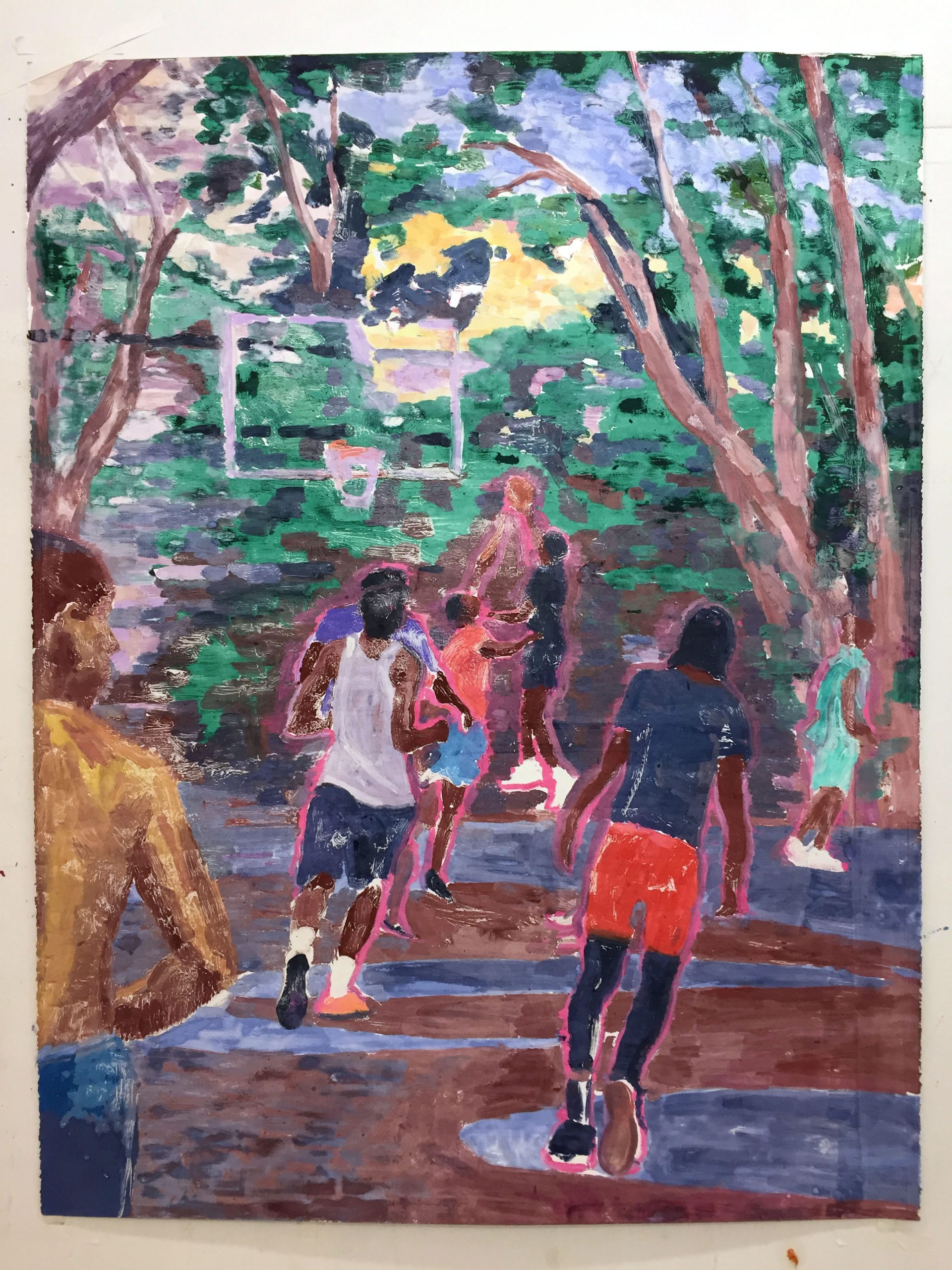
I feel that environment has a massive impact on making art, even if it’s subconscious. If you look back at making films and the work you were doing in Los Angeles do you see a difference in what you’ve been doing in New York? Obviously, you’re painting different physical spaces but has anything changed or evolved because of being in NYC?
I’ve pretty much been painting full time for years, and moving to Brooklyn has only helped. NYC is full of great painters and the opportunity to see great work here is unparalleled. Went to Chelsea this week and got to walk through Amy Sillman, Gina Beavers, Harold Ancart, and a Susanne Frecon show all in an hour. Fantastic, mind-blowing work. There’s so much great painting being done in NYC and it’s humbling and inspiring.
There is this constant weight and sort of “purpose” put on everything we do because of COVID-19. A lot of creative people I know have actually been demotivated due to the surplus of time or even feeling more pressure to make things. How’s it been for you?
It’s more important than ever to stay positive and move ahead with everything. We as artists can choose to “transmute” the tough emotions and dysfunction in our lives and society and create the space and vibe for new solutions. Working this year has been really difficult at times; feeling alone and feeling overwhelmed by how many people have been senselessly dying. But somehow I got to this place where I knew returning to the studio to work again and again was a way of creating stability and bringing positive energy into the world.
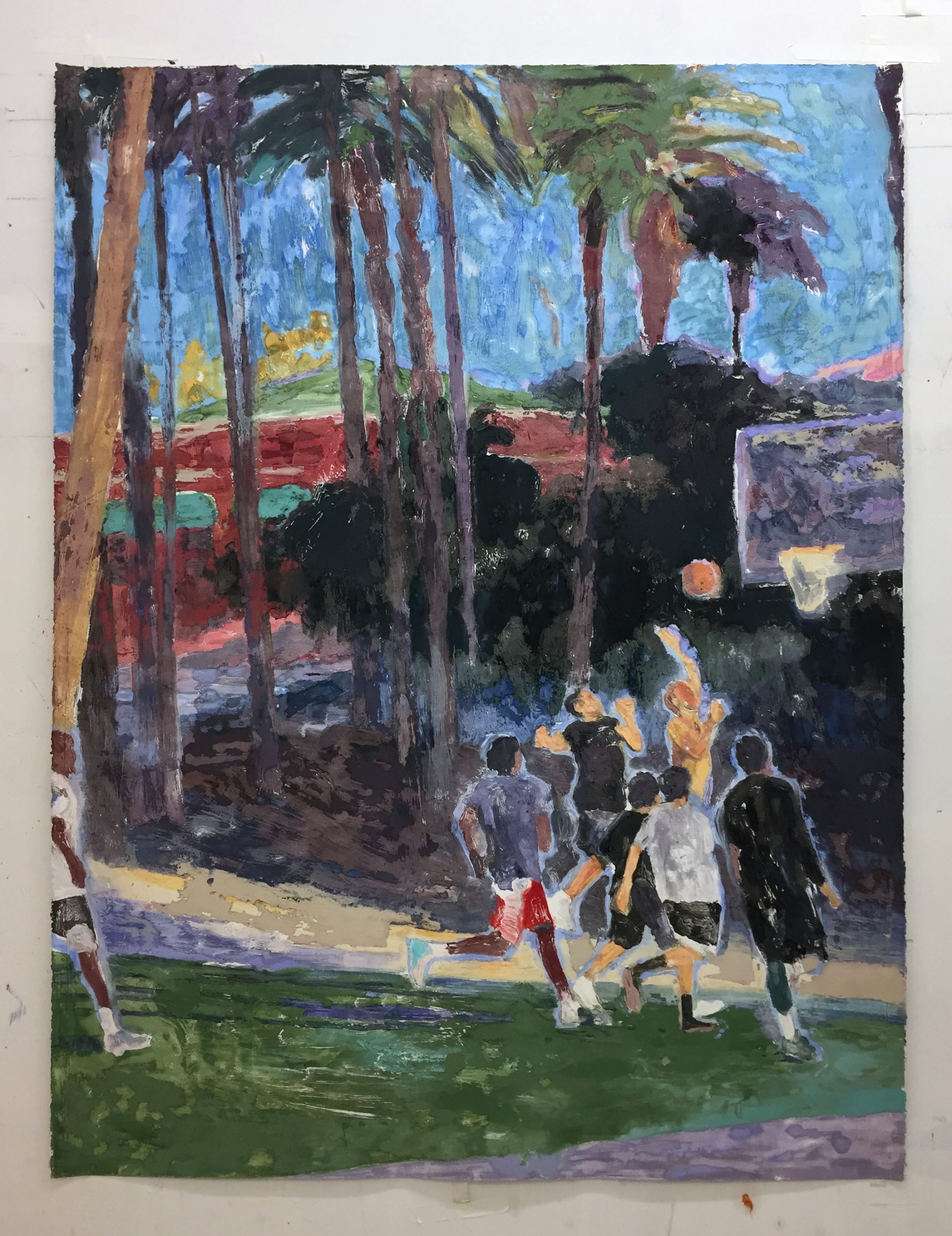
If we look back at sort of the public perception of painting since the last big “rock star” boom in the ’80s, why do you think the “art world” (not people who actually like art) are less focused on developing traditional painters and have shifted to almost commercial art or branded art?
Truth be told, painting is back and has been back in a major way since the early 2000’s both for the art world and the general art-loving public. There has been a renewed embrace of and return to painting and the tradition is very much alive and well. And women painters are kind of ruling it now. It’s very interesting and exciting. Katherine Bernhardt, Marlene Dumas, Nicole Eisenman, Kathy Bradford, and Petra Cortright just to name a few. In the same ways that in skateboarding, all types of moves and all periods of skateboarding are considered fair game now and no longer off-limits (handplants and wallrides are totally valid again), all kinds of painting and all periods of painting are now relevant and there’s less of a “supremacy” of any one kind of painting. In fact, there is NO kind of painting that dominates anything else. We can see a show of figure painting next to a show of gestural abstraction and they can both be relevant and interesting. It seems like Instagram has only accelerated the sense of what’s possible and painters are flourishing in Europe and Asia and Australia, and even places like Iran and Malaysia. Social media has really activated and pollinated a lot of people making art all over the world. Like skateboarding, Art is a language and a tremendous unifier.
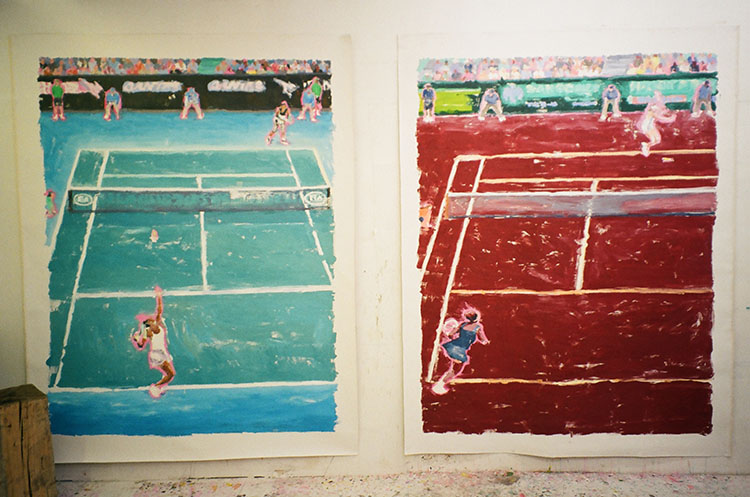
Can you talk a bit about the tennis works you have in the studio?
Several years ago I was on an airline flight and watching a tennis match. Something I wasn’t normally that into but that’s what happens on long flights. I was sketching the match and taking notes about the colors, and somehow decided to try and paint it just from the sketches. The first paintings came out cool and I realized that the geometry creates a nice foil for sloppy, painterly brushstrokes to sit up against. And then the colors of the courts became a thing to play with and it became a recurring subject for a while until last fall when I decided to try and scale up and paint some bigger courts and really let the court color and paint strokes become a central feature in the pieces.
I’ve enjoyed making the tennis pieces precisely because it is a subject I didn’t know much about and also because the compositions double as geometric abstractions. So again, it all comes back to exploring color. The tennis compositions have become a vehicle to explore color in a programmatic way. I’ve turned to using photos as a reference for nailing certain tennis players and their moves and also catching particular details in the crowd and of the referees and ball people. It’s a fascinating and very aesthetic little cosmos… the pro tennis match with refs and fans and brightly colored players. Although I use photos I try and improvise and alter the paintings to express a world closer to the one I really want to inhabit.
The last time I was in a museum was in March right before the lockdown in NYC. I think it’s super important to view things at scale and really pause because we have such short attention spans. There were a few moments where I was really sucked into some works, including a Bacon that normally isn’t something I’d like but maybe it was the mood but I was just floored and it felt different.
Seeing a Bacon painting in person is the way to go; those textures and gestures and the psychological intensity of his characters doesn’t come through in books or jpegs. Good paintings are fundamentally analog and the mechanics and optics work best when viewed in real-time.
What was your last museum visit or last time you saw something that really connected with or just hit you?
Amy Sillman curated this fantastic room of paintings pulled from MOMA’s permanent collection. I saw this show, “The Shape of Shapes” in March and I loved it for seeing the odd works of painter’s I love and also the way certain paintings were juxtaposed with other works. There was a really trippy, angular Schnabel painting there.
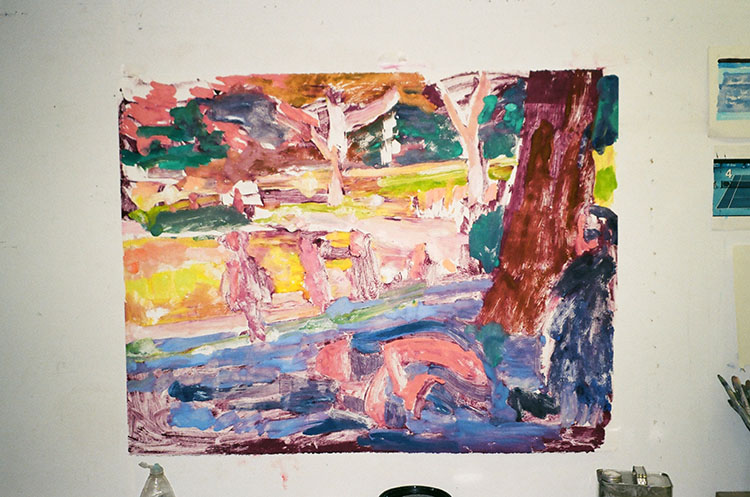
Would you describe your work as more process or feeling driven?
My painting absolutely depends on feeling and expressing certain feelings, but it’s a process that gets me there. My studio practice is very disciplined but feelings and expressing these feelings are at the core of my interest and explorations of color and subjects.
What’s next for Brian Lotti?
I have some smaller paintings in a group show my friend Louis Schmidt curated for the Droste Gallery in Germany, and have a painting in a group show at the Pit gallery in Los Angeles this fall. Other than this I’m stacking works for a proper solo show next year, details coming early spring. Thanks for the Q’s Anthony and cheers to this cool and quirky brand Weed Sport, super fun stuff!
For more on Brian follow him on Instagram: @brianlotti
Follow Anthony on Instagram: @anthony_pappa
And while you’re at it… Use the code TOPICAL20 for 20% off your next order.
Follow WeedSport on Instagram: @weedsportofficial

